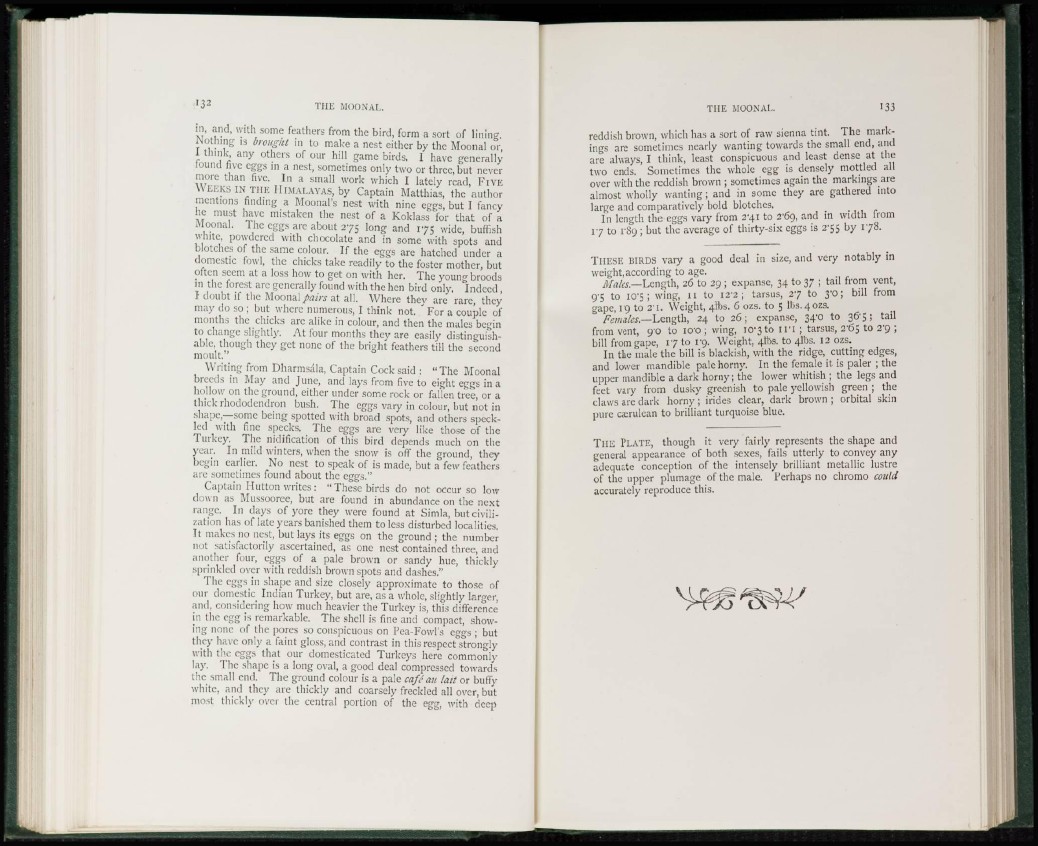
iii, and, with some feathers from the bird, form a sort of lining.
Nothing is brought in to make a nest either by the Moonal or,
I think, any others of our hill game birds. I have generally
found five eggs in a nest, sometimes only two or three, but never
more than five. In a small work which I lately read, Fi ve
WEEKS IN T H E HIMALAYAS, by Captain Matthias, the author
mentions finding a Moonal's nest with nine eggs, but 1 fancy
he must have mistaken the nest of a Koklass for that of a
Moonal. The eggs arc about 275 long and 175 wide, buffish
white, powdered with chocolate and in some with spots and
blotches of the same colour. If the eggs are hatched under a
domestic fowl, the chicks take readily to the foster mother, but
often seem at a loss how to get on with her. The young broods
in the forest are generally found with the hen bird only, Indeed ,
I doubt if the Moonal pairs at all. Where they are rare, they
may do so ; but where numerous, I think not. For a couple of
months the chicks arc alike in colour, and then the males begin
to change slightly. At four months tbey are easily distinguishable,
though they get none of the bright feathers till the second
moult."
Writing from Dharmsala, Captain Cock said : "The Moonal
breeds in May and June, and lays from five to eight eggs in a
hollow on the ground, cither under some rock or fallen tree, or a
thick rhododendron bush. The eggs vary in colour, but not in
shape,—some being spotted with broad spots, and others speckled
with fine specks. The eggs are very like those of the
Turkey, The nidification of this bird depends much on the
year. In mild winters, when the snow is off the ground, they
begin earlier. No nest to speak of is made, but a few feathers
are sometimes found about the eggs."
Captain Mutton writes : "These birds do not occur so low
down as Mussooree, but are found in abundance on the next
range. In days of yore they were found at Simla, but civilization
has of late years banished them to less disturbed localities.
It makes no nest, but lays its eggs on the ground ; the number
not satisfactorily ascertained, as one nest contained three, and
another four, eggs of a pale brown or sandy hue, thickly
sprinkled over with reddish brown spots and dashes."
The eggs in shape and size closely approximate to those of
our domestic Indian Turkey, but arc, as a whole, slightly larger,
and, considering how much heavier the Turkey is, this difference
in the egg is remarkable. The shell is fine and compact, showing
none of the pores so conspicuous on Pea-Fowl's eggs ; but
they have only a faint gloss, and contrast in this respect strongly
with the eggs that our domesticated Turkeys here commonly
lay. The shape is a long oval, a good deal compressed towards
the small end. The ground colour is a pale cafe au lait or buffy
white, and they are thickly and coarsely freckled all over, but
most thickly over the central portion of the egg, with deep
reddish brown, which has a sort of raw sienna tint. The markings
are sometimes nearly wanting towards the small end, and
are always, I think, least conspicuous and least dense at the
two ends. Sometimes the whole egg is densely mottled all
over with the reddish brown ; sometimes again the markings are
almost wholly wanting ; and in some they are gathered into
large and comparatively bold blotches.
In length the eggs vary from 2^41 to 2-6c), and in width from
1 7 to i'89; but the average of thirty-six eggs is 2'55 by 178.
T H E S E BIRDS vary a good deal in size, and very notably in
weight, according to age.
Males.—Length, 26 to 29 ; expanse, 34 to 37 ; tail from vent,
9'5 to I0'5 ; wing, 11 to I2'2 ; tarsus, 27 to 3'0; bill from
gape, r g to 2'I. Weight, 4lbs. 6 ozs. to 5 lbs. 4 ozs.
Females.—Length, 24 to 26; expanse, 34'0 to 36'S; tail
from vent, 90 to io"0 ; wing, iO'3to i n ; tarsus, 2'65 to 2'9 ;
bill from gape, 17 to 19. Weight, 4lbs. to 4R1S. 12 ozs.
In the male the bill is blackish, with the ridge, cutting edges,
and lower mandible pale horny. In the female it is paler ; the
upper mandible a dark horny; the lower whitish ; the legs and
feet vary from dusky greenish to pale yellowish green ; the
claws are dark horny ; irides clear, dark brown ; orbital skin
pure cerulean to brilliant turquoise blue.
T H E PLATE, though it very fairly represents the shape and
general appearance of both sexes, fails utterly to convey any
adequate conception of the intensely brilliant metallic lustre
of the upper plumage of the male. Perhaps no chromo could
accurately reproduce this.